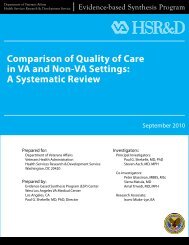VHA Systems Redesign; Transformational change in health care ...
VHA Systems Redesign; Transformational change in health care ...
VHA Systems Redesign; Transformational change in health care ...
Create successful ePaper yourself
Turn your PDF publications into a flip-book with our unique Google optimized e-Paper software.
<strong>Transformational</strong> Change <strong>in</strong> Health Care <strong>Systems</strong> 317<br />
year was not likely to <strong>in</strong>cur penalty or corrective action;<br />
<strong>in</strong>stead, the goal simply was moved to the next year.<br />
Integration<br />
Integration across traditional organizational boundaries<br />
occurred at a later stage of transformation <strong>in</strong> our study<br />
systems. Consistent with the Baldrige framework, <strong>in</strong>tegration<br />
was needed to break down and bridge boundaries<br />
between <strong>in</strong>dividual components so that a system<br />
operated as a fully <strong>in</strong>terconnected unit to support<br />
organization-wide goals (Baldrige National Quality<br />
Program, 2005). In Figure 1, <strong>in</strong>tegration is represented<br />
as a horizontal l<strong>in</strong>e to signify the importance of work<strong>in</strong>g<br />
across <strong>in</strong>tra-organizational boundaries. In our model,<br />
<strong>in</strong>tegration is a multifaceted concept that applies to all<br />
organizational levels and is both an end state for a highperform<strong>in</strong>g<br />
system and a strategy for transformation. As<br />
a strategy, <strong>in</strong>tegrat<strong>in</strong>g structures and processes can<br />
facilitate the spread of improved cl<strong>in</strong>ical practices across<br />
the organization.<br />
All study systems worked to <strong>in</strong>tegrate cl<strong>in</strong>ical <strong>care</strong> to<br />
improve coord<strong>in</strong>ation and cont<strong>in</strong>uity of <strong>care</strong>. At the front<br />
l<strong>in</strong>e, extensive work on patient flow, case management,<br />
and electronic support systems (e.g., cl<strong>in</strong>ical rem<strong>in</strong>ders<br />
and registries) was aimed toward improv<strong>in</strong>g <strong>care</strong> for <strong>in</strong>dividual<br />
patients or populations. Several study systems developed<br />
comprehensive planned <strong>care</strong> models to <strong>in</strong>tegrate<br />
patient <strong>care</strong> processes across workgroups, microsystems,<br />
or the entire organization. Some systems used service<br />
l<strong>in</strong>es to <strong>in</strong>tegrate providers and support staff to improve<br />
coord<strong>in</strong>ation of patient <strong>care</strong>. However, some service l<strong>in</strong>e<br />
structures also created new silos, <strong>in</strong>tegrat<strong>in</strong>g <strong>care</strong> with<strong>in</strong><br />
the l<strong>in</strong>es but imped<strong>in</strong>g <strong>in</strong>tegration across them.<br />
Also at the front l<strong>in</strong>e, all systems facilitated <strong>care</strong><br />
<strong>in</strong>tegration through multidiscipl<strong>in</strong>ary improvement<br />
teams that encouraged communication and problem<br />
solv<strong>in</strong>g across work units. However, by themselves,<br />
improvement teams ran up aga<strong>in</strong>st the limits of<br />
traditional <strong>in</strong>tra-organizational boundaries. Often teams<br />
could not obta<strong>in</strong> the commitment of resources or the<br />
cooperation from other departments needed to effect<br />
<strong>change</strong>. Without such collaboration, improvement efforts<br />
could not fully make the <strong>change</strong>s necessary to<br />
address sources of problems and to build improvement<br />
<strong>in</strong>to the organization such that last<strong>in</strong>g <strong>change</strong> occurs.<br />
For example, some study systems work<strong>in</strong>g on<br />
medication errors were unable to acquire resources<br />
to implement new technologies, such as bar cod<strong>in</strong>g,<br />
which resulted <strong>in</strong> less than fully effective workarounds.<br />
To move beyond the limits of a team’s or service l<strong>in</strong>e’s<br />
authority and resources, <strong>in</strong>tegration also was needed at the<br />
systems or organizational level <strong>in</strong> the form of structures<br />
and processes that <strong>in</strong>volved managers with decisionmak<strong>in</strong>g<br />
authority and responsibilities spann<strong>in</strong>g the organization.<br />
However, <strong>in</strong>tegration at these high levels <strong>in</strong><br />
our study sites appeared to be more difficult to achieve. As<br />
one manager <strong>in</strong> Site G expressed it,<br />
Gett<strong>in</strong>g people to talk to each other, break<strong>in</strong>g down<br />
silos, and gett<strong>in</strong>g people to work across units [is<br />
frustrat<strong>in</strong>g]....Hospitals really do have silos and<br />
they are there for good reasons. What would be<br />
ideal is a tunnel that goes all the way across that<br />
would allow us to share each other’s goals. You need<br />
a dynamism that takes people out of the structure<br />
and creates a new way of do<strong>in</strong>g th<strong>in</strong>gs.<br />
A deliberate focus on <strong>in</strong>tegration often occurred after<br />
an organization had learned to do redesign work and to<br />
address alignment. Many study systems used quality<br />
management steer<strong>in</strong>g committees to address crossorganizational<br />
issues <strong>in</strong> high-priority QI efforts, but<br />
only a few moved beyond <strong>in</strong>tegration around improvement<br />
projects to build <strong>in</strong>tegration <strong>in</strong>to the way they<br />
worked by us<strong>in</strong>g standard or newly <strong>in</strong>vented management<br />
structures. Site D, for <strong>in</strong>stance, redesigned its<br />
horizontal management structures to create multidiscipl<strong>in</strong>ary<br />
groups responsible for <strong>care</strong> processes def<strong>in</strong>ed by<br />
patients’ experiences (e.g., <strong>in</strong>patient, outpatient, and<br />
emergency <strong>care</strong> teams). In addition, an <strong>in</strong>tegration<br />
committee staffed by senior leaders, <strong>in</strong>clud<strong>in</strong>g the CEO,<br />
addressed redundancy, conflicts, and the spread of best<br />
practices across groups. Site D saw these structures as<br />
transitional, recogniz<strong>in</strong>g <strong>in</strong>consistencies with other<br />
structures <strong>in</strong> the medical center.<br />
A Dynamic Model: Interaction<br />
and Iteration<br />
The five critical elements of the model did not operate<br />
<strong>in</strong> isolation. Rather, they occurred <strong>in</strong> and through<br />
the context of complex and dynamic <strong>health</strong> <strong>care</strong><br />
organizations. Substantial systemic <strong>change</strong> required<br />
<strong>in</strong>teraction of the key elements with one another and<br />
with the rest of the organization, as illustrated <strong>in</strong><br />
Figure 1. Our model shows the <strong>in</strong>terconnections among<br />
elements that support transformational <strong>change</strong>, as called<br />
for <strong>in</strong> the Quality Chasm (IOM, 2001).<br />
To illustrate the importance of these <strong>in</strong>teractions, we<br />
found that improvement <strong>in</strong>itiatives were unlikely to be<br />
susta<strong>in</strong>ed or spread across the organization if they were<br />
not l<strong>in</strong>ked to the organization’s management structure<br />
and work processes. Structures and processes to create<br />
alignment and <strong>in</strong>tegration were critical to establish<strong>in</strong>g<br />
those l<strong>in</strong>ks. When an improvement <strong>in</strong>itiative was<br />
aligned with the organization’s priorities and strategic<br />
direction, senior managers were more likely to provide<br />
the needed <strong>in</strong>frastructure resources (e.g., staff time,<br />
funds, and data systems) and to hold staff accountable for<br />
Copyright @ Lipp<strong>in</strong>cott Williams & Wilk<strong>in</strong>s. Unauthorized reproduction of this article is prohibited.

















